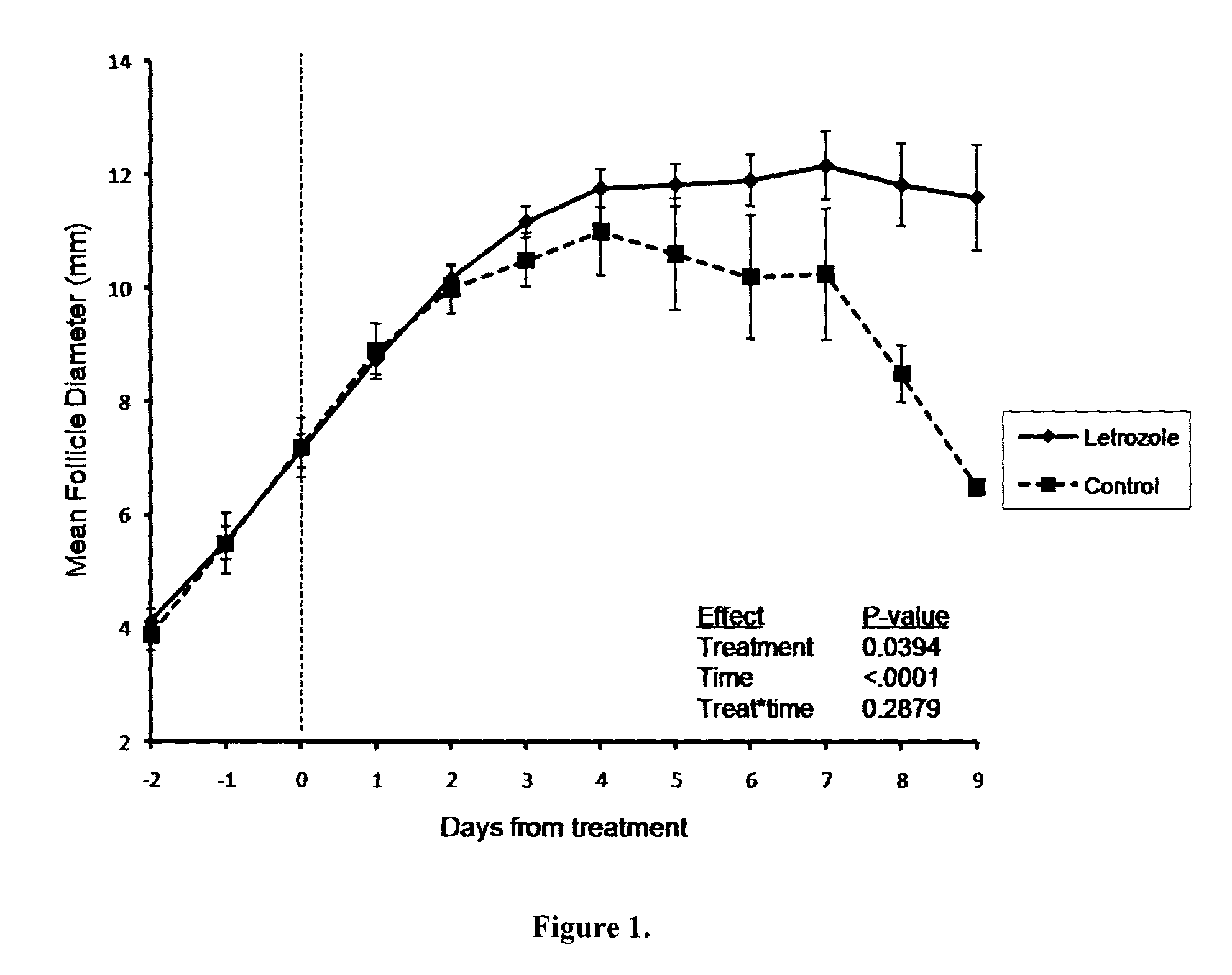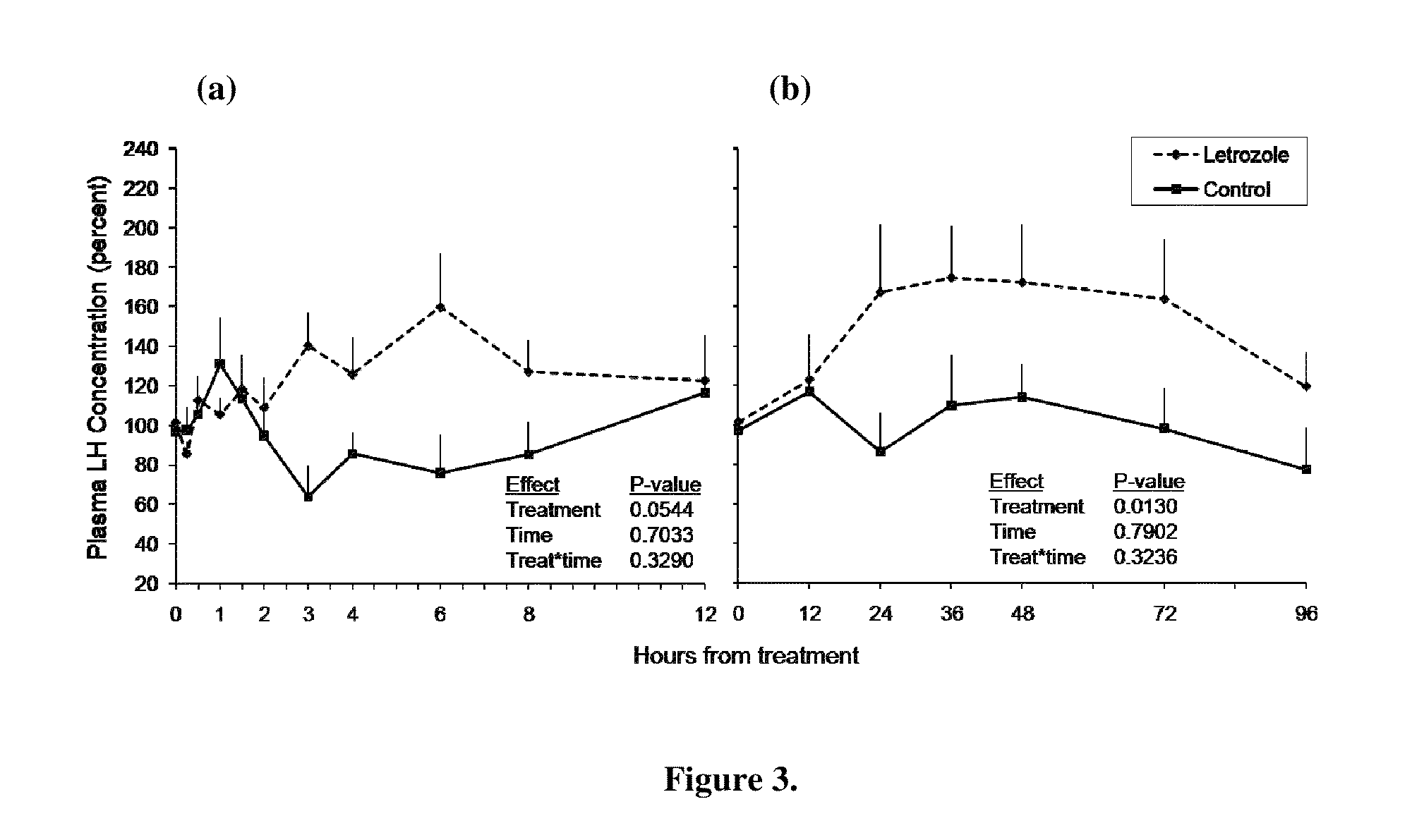Methods of administering an aromatase inhibitor, prostaglandin and GnRH for regulating ovulation in cattle
an aromatase inhibitor and aromatase inhibitor technology, applied in the direction of peptides, drug compositions, peptides, etc., can solve the problems of inefficiency of ai programs, lower insemination frequency, and inefficient reproduction in cattle, so as to improve the frequency of successful implantation and development of fertilized ova
- Summary
- Abstract
- Description
- Claims
- Application Information
AI Technical Summary
Benefits of technology
Problems solved by technology
Method used
Image
Examples
example i
Materials and Methods
Cattle
[0108]Hereford-cross beef heifers, 14 to 20 months of age and weighing between 295 and 450 kg, were chosen from a herd of 50 heifers maintained in outdoor corrals at the University of Saskatchewan Goodale Research Farm (52° North and 106° West). Heifers were fed alfalfa / grass hay and grain to gain approximately 1.3 Kg per day and had water ad libitum during the experimental period from July to October. Heifers were initially examined by transrectal ultrasonography (7.5 MHz linear-array transducer, Aloka SSD-900; Tokyo, Japan) to confirm that they were postpubertal by observing the presence of a CL [33].
Treatments and Examinations
[0109]Heifers in which a CL was detected during the initial examination were given 500 of cloprostenol (PGF, Estrumate™, Schering-Plough Animal Health, Pointe-Claire, QC, Canada) intramuscularly (im) to induce regression of the CL and to synchronize ovulation [34]. Heifers were examined daily by transrectal ultrasonography to detec...
example — ii
Example—II
Material and Methods—II
Cattle
[0134]Hereford-cross beef heifers, 14 to 20 months of age and weighing between 233 and 404 kg, were chosen from a herd of 50 animals maintained in outdoor corrals at the University of Saskatchewan Goodale Research Farm (52° North and 106° West). Heifers were fed alfalfa / grass hay and grain to gain approximately 1.3 kg per day and had water ad libitum during the experimental period from May to July. Heifers were initially examined by transrectal ultrasonography (7.5 MHz linear-array transducer, Aloka SSD-900; Tokyo, Japan) to confirm that they were postpubertal by the presence of a CL [33].
Treatments and Examinations
[0135]Heifers in which a CL was detected during the initial examination underwent transvaginal ultrasound-guided follicular ablation of the two largest ovarian follicles to synchronize follicular wave emergence, which was expected to occur 1 to 1.5 days later [34, 35]. Four days after follicular ablation, heifers were given 500 μg of...
example — iii
Example—III
Material and Methods—III
[0168]Ovarian cyclicity in heifers was synchronized using transvaginal ultrasound-guided follicular ablation followed by a double dose of PGF 4 days after ablation. The ovaries were examined daily by transrectal ultrasonography to detect ovulation. Three days after ovulation, heifers were assigned randomly to four treatment groups and given letrozole at a dose of 1 mg / kg intravenously (in benzyl alcohol, n=10) or intramuscularly (in benzyl alcohol plus canola oil 1:1 v / v, n=10), or given a placebo intravenously (benzyl alcohol, n=5) or intramuscularly (benzyl alcohol plus canola oil 1:1 v / v, n=5). Ovarian structures were monitored by ultrasonography and blood samples were collected by jugular venipuncture twice daily from pre-treatment to post-treatment ovulations. Comparisons among groups were made by one-way ANOVA for single-point measurements and by ANOVA for repeated measures for time-series data.
[0169]Blood samples collected daily from treatme...
PUM
| Property | Measurement | Unit |
|---|---|---|
| Time | aaaaa | aaaaa |
| time | aaaaa | aaaaa |
| weight | aaaaa | aaaaa |
Abstract
Description
Claims
Application Information
 Login to View More
Login to View More - R&D
- Intellectual Property
- Life Sciences
- Materials
- Tech Scout
- Unparalleled Data Quality
- Higher Quality Content
- 60% Fewer Hallucinations
Browse by: Latest US Patents, China's latest patents, Technical Efficacy Thesaurus, Application Domain, Technology Topic, Popular Technical Reports.
© 2025 PatSnap. All rights reserved.Legal|Privacy policy|Modern Slavery Act Transparency Statement|Sitemap|About US| Contact US: help@patsnap.com



